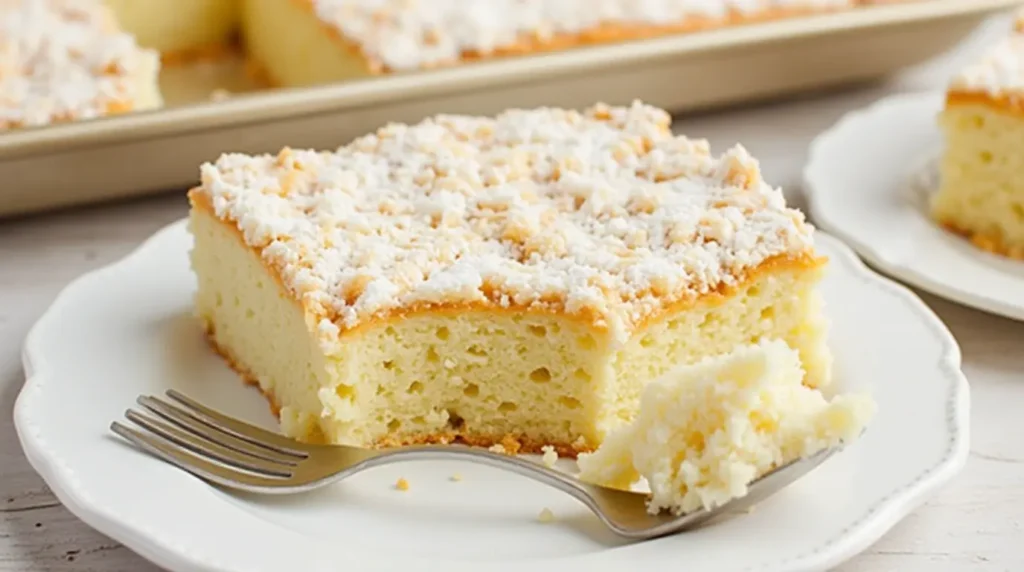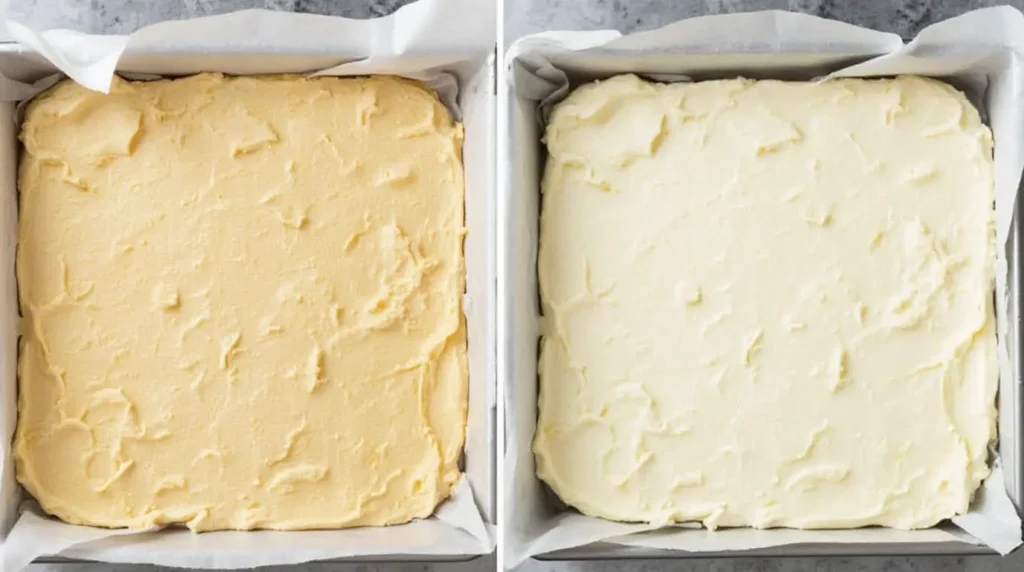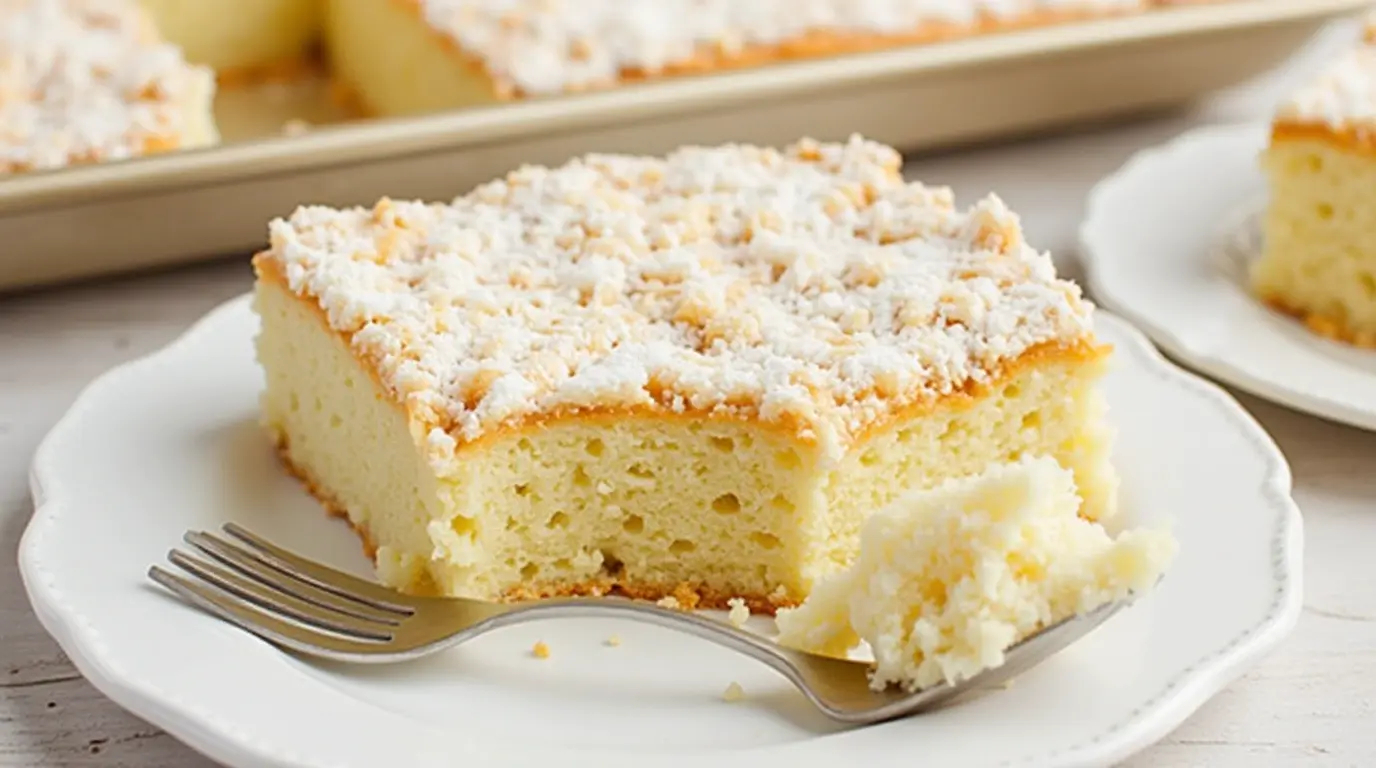Baking can be a soothing and rewarding experience, and nothing beats the joy of making a delicious, moist, and fluffy easy kefir sheet cake from scratch. Whether you’re new to baking or a seasoned pro, this step-by-step guide will show you how to create a foolproof cake that your family will love. With its tangy flavor and perfect texture, kefir adds a unique twist to a classic sheet cake.
This cake is perfect for breakfast, an afternoon snack, or even a light dessert. Its balanced sweetness, tender crumb, and probiotic-rich kefir make it a healthier option compared to traditional cakes. Plus, it’s incredibly simple to prepare, requiring only a handful of pantry staples. Let’s dive in!

Table of Contents
What is Kefir and Why Use It in Baking?
Understanding Kefir
- Kefir is a fermented dairy product made by culturing milk with kefir grains, which are a combination of bacteria and yeast.
- It has a slightly tangy, creamy taste, similar to buttermilk, but with a more complex flavor profile.
- Originating from the Caucasus region, kefir has been consumed for centuries as a probiotic-rich health drink.
- It is packed with essential nutrients, including protein, calcium, vitamin B12, riboflavin, magnesium, and vitamin D.
- The probiotics found in kefir promote gut health, support digestion, and may boost the immune system.
- Available in various forms, including dairy and non-dairy options, making it accessible for different dietary needs.
Benefits of Using Kefir in Baking
- Enhances Moisture: Kefir adds a creamy texture and moisture to cakes, making them soft and tender.
- Acts as a Natural Leavening Agent: The mild acidity of kefir reacts with baking soda, creating air pockets that help cakes rise beautifully.
- Boosts Nutritional Value: Unlike regular milk, kefir contains beneficial probiotics that support gut health and digestion.
- Improves Flavor and Texture: The slight tanginess of kefir complements the sweetness of baked goods, balancing flavors perfectly.
- Reduces the Need for Excess Fat: Due to its high moisture content, kefir allows for a reduction in butter or oil without compromising texture.
- Makes Cakes Lighter and Fluffier: The fermentation process of kefir helps break down gluten, resulting in a more tender crumb.
- Increases Shelf Life: Cakes made with kefir tend to stay fresh longer due to its natural fermentation properties.
Types of Kefir You Can Use
- Dairy Kefir: Traditional kefir made from cow, goat, or sheep’s milk. It has a creamy consistency and is widely used in baking.
- Non-Dairy Kefir: Made from coconut milk, almond milk, or oat milk, this is a great option for those who are lactose-intolerant or vegan.
- Homemade Kefir: You can easily make your own kefir at home using milk and kefir grains. This ensures maximum probiotic content and quality.
- Store-Bought Kefir: Readily available in grocery stores in various flavors. For baking, always opt for plain, unsweetened versions to avoid excess sugar.
How Kefir Differs from Other Dairy Products
- Compared to Yogurt: While both are probiotic-rich, kefir has a thinner consistency and a more diverse range of beneficial bacteria and yeast.
- Compared to Buttermilk: Buttermilk is cultured with lactic acid bacteria and has a milder taste, whereas kefir is fermented with a mix of bacteria and yeast, giving it a more complex, slightly carbonated texture.
- Compared to Regular Milk: Unlike plain milk, kefir is predigested due to the fermentation process, making it easier to digest and gentler on the stomach.
Ingredients for the Best Easy Kefir Sheet Cake
A great kefir sheet cake starts with high-quality ingredients. Here’s everything you’ll need, along with some optional add-ins to customize your cake:
Essential Ingredients
| Ingredient | Quantity | Notes |
|---|---|---|
| All-purpose flour | 2 cups | Can substitute with whole wheat flour for a healthier version |
| Sugar | 1 cup | Adjust according to taste |
| Eggs | 2 large | Room temperature for better mixing |
| Kefir | 1 cup | Use plain, unsweetened kefir |
| Baking powder | 2 tsp | Ensures the cake rises properly |
| Baking soda | 1/2 tsp | Reacts with kefir for extra fluffiness |
| Salt | 1/4 tsp | Enhances overall flavor |
| Vanilla extract | 1 tsp | Adds a pleasant aroma |
| Vegetable oil | 1/2 cup | Keeps the cake moist |
| Butter (melted) | 1/4 cup | Adds richness to the texture |
| Lemon zest (optional) | 1 tsp | Enhances flavor with a fresh citrus note |
| Cinnamon (optional) | 1/2 tsp | Adds warmth and depth to the cake |

Optional Add-ins for Extra Flavor
- Chocolate Chips: Fold in 1/2 cup for a hint of sweetness.
- Chopped Nuts: Walnuts or almonds add a crunchy texture.
- Dried Fruits: Raisins, cranberries, or chopped dates for natural sweetness.
- Coconut Flakes: Adds a tropical twist to your cake.
- Spices: Nutmeg, cardamom, or ginger for more warmth and depth.
Ingredient Substitutions
- Flour Alternatives: Swap all-purpose flour with whole wheat flour for a more fiber-rich option or gluten-free flour for a celiac-friendly cake.
- Sugar Alternatives: Use coconut sugar, honey, or maple syrup for a natural sweetener.
- Oil Substitutes: Replace vegetable oil with coconut oil or applesauce for a lighter version.
- Dairy-Free Option: Use non-dairy kefir and substitute butter with coconut oil or vegan butter.
By selecting high-quality ingredients and tweaking them to fit your preferences, you can create a customized, flavorful kefir sheet cake that suits your dietary needs!
Step-by-Step Guide to Making Easy Kefir Sheet Cake
Step 1: Prepare the Baking Pan and Preheat the Oven
- Preheat your oven to 350°F (175°C).
- Grease a 9×13-inch baking sheet with butter or line it with parchment paper.
- Lightly dust with flour to prevent sticking.
Step 2: Mix Dry Ingredients
- In a large bowl, whisk together flour, baking powder, baking soda, salt, and optional cinnamon.
- Sift the dry ingredients to remove any lumps and ensure even distribution.
Step 3: Beat the Wet Ingredients
- In another bowl, beat eggs and sugar until light and fluffy.
- Add kefir, vanilla extract, vegetable oil, and melted butter.
- Whisk until the mixture is smooth and well combined.
- Stir in optional lemon zest for an extra layer of flavor.
Step 4: Combine Wet and Dry Ingredients
- Slowly mix the dry ingredients into the wet ingredients.
- Stir gently using a spatula or hand mixer until fully incorporated.
- Avoid overmixing to keep the cake tender.
Step 5: Bake the Cake
- Pour the batter into the prepared baking pan.
- Tap the pan gently to remove any air bubbles.
- Bake for 25-30 minutes, or until a toothpick inserted in the center comes out clean.
Step 6: Cool and Serve
- Let the cake cool in the pan for 10-15 minutes.
- Transfer to a wire rack to cool completely.
- Slice and serve as-is or with your favorite frosting.
Step 7: Optional Toppings and Frosting
- Dust with powdered sugar for a simple finish.
- Drizzle with a light glaze made of powdered sugar and lemon juice.
- Spread a layer of cream cheese or whipped frosting for added richness.
- Garnish with fresh berries or nuts for extra texture and flavor.
Additional Serving Ideas
Complementary Drinks
- Pair your cake with hot coffee, tea, or a glass of warm milk.
- Serve alongside a kefir smoothie for a probiotic boost.
Adding Texture
- Sprinkle crushed nuts like almonds or walnuts for extra crunch.
- Add a handful of chocolate chips or raisins into the batter for variety.
Making It Festive
- Decorate with colorful sprinkles for birthdays.
- Add edible flowers or a light dusting of powdered sugar for an elegant touch.

Topping and Frosting Ideas for Kefir Sheet Cake
Classic Options
- Simple powdered sugar dusting.
- Vanilla glaze for added sweetness.
Healthy Alternatives
- Greek yogurt frosting for a tangy touch.
- Fresh fruit and honey drizzle.
Decadent Choices
- Chocolate ganache for a rich flavor.
- Cream cheese frosting for a smooth and creamy finish.
Tips for the Perfect Kefir Sheet Cake
- Always use room temperature ingredients for a smooth batter.
- Don’t overmix, as this can make the cake dense.
- Allow the cake to cool completely before adding frosting.
- Store in an airtight container for up to 3 days.
- Experiment with flavors by adding nuts, dried fruits, or citrus zest.
- For extra moisture, brush the baked cake with a light sugar syrup before frosting.
- Substitute half the flour with almond flour for a nutty variation.
- Serve with a side of tea, coffee, or a scoop of vanilla ice cream for an extra treat.
Frequently Asked Questions
1. Can I substitute buttermilk for kefir?
Yes! Buttermilk works as a great alternative to kefir in this recipe, though kefir provides additional probiotics and a unique tangy flavor.
2. How do I make this kefir sheet cake gluten-free?
Simply swap the all-purpose flour for a gluten-free flour blend.
3. Can I freeze kefir sheet cake?
Yes, wrap the cake tightly in plastic wrap and store in the freezer for up to 2 months.
4. What’s the best way to store kefir sheet cake?
Keep it in an airtight container at room temperature for up to 3 days or in the fridge for up to a week.
5. Can I add cocoa powder to make a chocolate kefir cake?
Yes! Add 1/4 cup of unsweetened cocoa powder to the dry ingredients for a chocolate version.
6. What are some variations of this kefir cake?
Try adding cinnamon and nutmeg for a spiced cake, or mix in berries for a fruity twist.
Conclusion
Making an easy kefir sheet cake is simple, delicious, and rewarding. With its moist texture and mild tanginess, this cake is perfect for any occasion. Follow this guide, experiment with toppings, and enjoy a homemade treat that’s both healthy and indulgent! Whether you’re baking for a family gathering or just treating yourself, this kefir sheet cake will become a go-to favorite. Try it today and share your results with friends and family!
By following this comprehensive guide, you’ll not only master the art of baking with kefir but also enjoy a cake that’s packed with probiotics and flavor. Happy baking!

